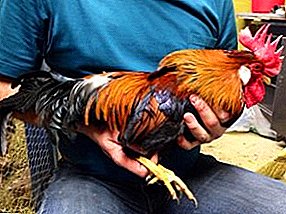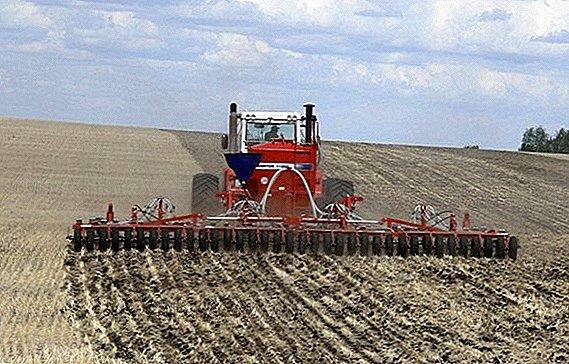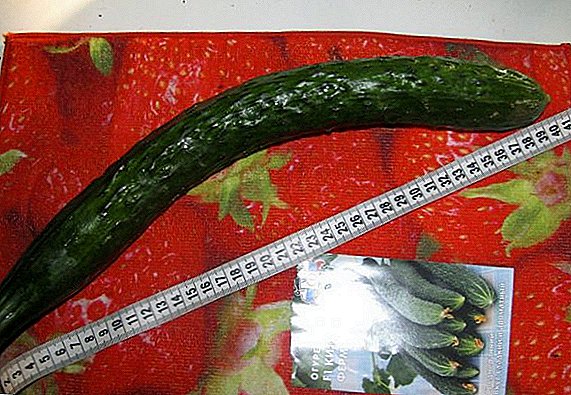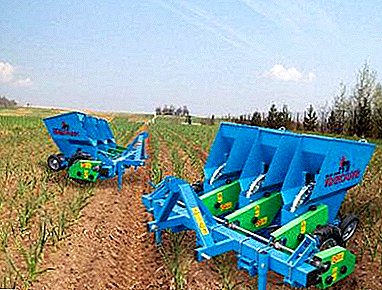
When working with sowing different crops, it is sometimes necessary to automate manual labor. For this purpose, the farm uses special mechanical seeders for potatoes, onions and other vegetables.
The seeder for garlic carries the name "garlic planter". It helps to facilitate manual labor, while providing an excellent result. After all, the final result directly depends on the quality of sowing.
Using the drawings, you can make a hand planter for garlic with your own hands, or even a special device for the walker. How to do this and what may be the pros and cons, we will describe in detail in this article.
Operating principle
The principle of operation of garlic planters is quite simple. The device consists of a frame, sprocket, chain, gearbox and seed container. Garlic is poured into the container before planting. Next, the seeder automatically cuts a small furrow in the ground and plants each clove of garlic in the ground, then sprinkles it with the help of a coulter.
What is used for planting?
Of course, planting garlic can be done manually. However, if the scale of sowing is much larger than a pair of beds, without such an adaptation, labor will be much harder and take much longer. Therefore, even in small farms, it makes sense to purchase at least a manual seeder.
Kinds
There are dozens of models of garlic planters on the market, however According to the principle of operation, 3 main types can be distinguished.:
- manual garlic planter;
- seeder on the motor-block;
- seeder tractor.
Manual
The most economical option. Used in small areas. However, it requires physical effort: you need to set up the seeder yourself, take it to the site and drive the seeder in front of you, passing through the entire planting line.

On walking tractor
Attached to the walker. For work, it is enough to use special mounts and adjust the device to the desired mode.

On the tractor
Attached to the tractor. Such a seeder is suitable for processing large areas, the design is quite massive. Allows you to plant a large number of seeds.

Different rows of the device
In addition to other parameters, garlic planters differ in the number of rows they can sow at the same time. Different models can have from one to six rows.. At the same time, the manual ones almost always have 1 row, because additional rows make the structure heavier and make it less stable, which means it will be more difficult to work with it.
Planters on a walker tractor have from one to four rows, and only in models for a tractor there are 5-6 rows each. In addition, some planters have removable containers, which allows you to adjust the rows.
Pros and cons of various types of devices
| Kinds | Manual | On walking tractor | On the tractor |
| pros |
|
|
|
| Minuses |
|
|
|
Garlic digger and garlic planter - what's the difference?
The names are so similar that there may be confusion. However, the functions of these types of technology are different. Garlic digger - a device for automating the digging of garlic, that is, harvesting. It also incorporates a chain and containers, and can be mounted on a tractor, or on a walk-behind tractor, like a garlic planter. In the process, garlic bulbs are snatched from the ground and collected in a container.
Buy or build a homemade?
Assembling a landing device with your own hands is not that difficult., even at home. But it is advisable only in a few cases:
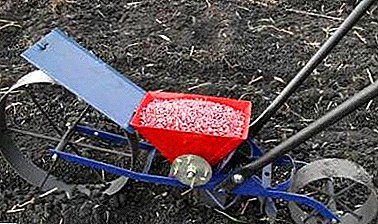 The owner has all the necessary materials. It is important to take a drawing in advance, according to which the planter will be created, and check whether everything is in stock. Some parts (for example, a chain) can be taken from an old bicycle, others (mounts, containers) can be taken from the garage or workshop. Of course, you can buy a couple of things, but if you separately purchase all the components, it will be easier and cheaper to buy a ready-made device.
The owner has all the necessary materials. It is important to take a drawing in advance, according to which the planter will be created, and check whether everything is in stock. Some parts (for example, a chain) can be taken from an old bicycle, others (mounts, containers) can be taken from the garage or workshop. Of course, you can buy a couple of things, but if you separately purchase all the components, it will be easier and cheaper to buy a ready-made device.- The owner is more or less familiar with agricultural machinery. Otherwise, it may be difficult, even if before your eyes a clear instruction and drawings.
- It is necessary to make the device "by itself". For example, make removable containers for different seeds or install containers for fertilizer and watering. In stores, seeders with advanced features always cost more, and in this case, the savings are substantial.
If you do not want to mess with the drawings and the device, collect spare parts, or do not have enough time for all this, the best choice would be to buy a manual drill in special stores.
How to choose?
There are several basic signs by which it can be determined that the technique for planting garlic is appropriate in one case or another.
- Principle of operation. The main principle of operation for all the planters is the same: the cloves or bulbs of garlic are picked up on a chain and planted in a furrow to a certain depth, after which they are covered with earth. The choice of power and rowset device depends on the size of the site and the scale of the economy.
The main types can be divided as follows:
- For small gardens with loose soil: manual planter.
- For medium plots: garlic planter on the walker.
- For large farms: seeder for tractor.
- Weight. Manual garlic planters weigh up to 10 kg. In this case, the principle “the easier, the better” works, since the additional weight complicates manual labor. Garlic seed drills on the motoblock have a mass of from 10 to 70 kg.
It all depends on the model and the number of rows. Four-row planters can usually be mounted on both the tractor and motorblock. The seeders on the tractor are the most massive: from 70 to 100 kg and more. Here, the choice of device should be done taking into account the power of the tractor. Mini tractor models weigh less.
- Price.
- Manual: the cheapest of all, but rarely sold in specialty stores. The average price of about 5000 p.
- On walking tractor: much more expensive. Prices vary from 20 000 to 40 000 r.
- On the tractor: the most expensive. The cheapest models cost a little more than 30 000 r., And expensive ones - more than 100 000 r., Sometimes the price comes up to 200 000 r.
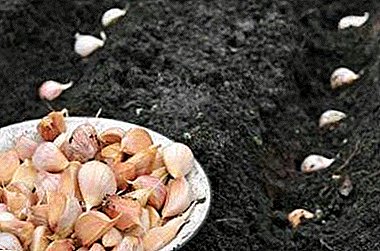 Seeding type. The type of seeding does not depend on the type of garlic planter, but on the size of the bowls, the depth of planting and the number of rows. For the bulbs of garlic, planters are suitable only with small bowls, as they provide spot seeding - one bulb at a time. Large and medium bowls are suitable for teeth, in such models several teeth are planted in one place. Suitable seeding depth for seeds: 6-8 cm, and for garlic cloves: 15-20. The seeding rate depends on the rows.
Seeding type. The type of seeding does not depend on the type of garlic planter, but on the size of the bowls, the depth of planting and the number of rows. For the bulbs of garlic, planters are suitable only with small bowls, as they provide spot seeding - one bulb at a time. Large and medium bowls are suitable for teeth, in such models several teeth are planted in one place. Suitable seeding depth for seeds: 6-8 cm, and for garlic cloves: 15-20. The seeding rate depends on the rows.Manual planters are almost always single-row, and the number of rows in the motor-block drills varies from 1 to 4. For the bulbs of garlic, a four-row planter is suitable. It is considered one of the best, as it provides a more even sowing. And for the largest areas, it is effective to use 6-row planters (usually such models are only for tractors), which will significantly save planting time.
- Manufacturer. Domestic and Ukrainian manufacturers are leading in the market: Poltava, Yarilo, Zvezda, Premium, Bulat, etc. If you wish, you can also find foreign brands. Prices do not depend on the brand, but on specific models and dimensions of the seeders.
Models
| Type of | Model name | Row | Depth of landing (cm) | Weight, kg) |
| Manual | SMK-3 VPS27 / 1-10 / 4 | 3-row | 1-3 | 3 |
| Garlic Sazhalka Premium 1-row | 1 row | 6-8 | 20 | |
| Sazhalka for garlic 1-row manual with the bunker for fertilizers Yarilo | 1 row | 6-8 | 15 | |
| Sazhalka for garlic 1-row manual Yarylo with a basic wheel | 1 row | 6-8 | 15 | |
| On walking tractor | 1-row seed drill CHS-1 | 1 row | 6-8 | 20 |
| 2-row model CS-2 | 2-row | 6-8 | 44 | |
| Nozzle for TM ProTek motoblock | 1-4 rows (removable rows) | 1-10 | 60 | |
| Sazhalka for garlic hook-on SCH-2 to the motor-block | 2-row | 6-8 | 44 | |
| On the tractor | Four-row ES-4 | 4-row | 8-10 | 73 |
| Sazhalka for garlic hook-on СЧТ-4 to a tractor | 4-row | 6-8 | 98 | |
| 6-row garlic planter for mini tractor | 6-row | 6-8 | 135 |
Where can I buy?
- Garden-shop.
- On the walker: 2-row planters (20 -25 thousand rubles).
- On a tractor: 4 rows (40-50 thousand rubles).
- Delivery in St. Petersburg and Moscow: 1 000 p. plus 35 rubles / km outside the city (St. Petersburg) and 40 rubles / km outside the city (Moscow).
- Tiu.ru.
 Manual: 1-row (10 thousand rubles).
Manual: 1-row (10 thousand rubles).- On the walk-behind tractor: 2-row (from 20 thousand rubles), 3-row (from 30 thousand rubles), 4-row (from 40 thousand rubles).
- On a tractor: 3-row for mini tractors (from 20 thousand rubles) and 6-row (from 60 thousand rubles).
- There are universal planters - from 100 to 200 thousand rubles.
- Pickup in St. Petersburg and Moscow.
- Shipping cost 500 p.
- Agrotrade.
- On a tractor: 3-row (100 thousand rubles) and 4-row (200 thousand rubles).
- The timing, cost and method of delivery by region depends on the weight of the cargo, dimensions and final destination, and in each case is coordinated with the store manager.
- Hardware Store 100kwatt.ru.
- On the walker: 2-row and 4-row (from 20 thousand rubles).
- On a tractor: 4-row (from 40 thousand rubles).
- Shipping cost is calculated individually.
How to make a planter?
Materials:
- transparent plastic can (will be a container for seeds);
- bolt;
- plastic tube (you will need to cut a piece that fits to the bank in depth);
- the metal tube is slightly narrower;
- 2 washers for fixing the jar;
- nut;
- tin can (you can just cover it);
- aluminum wire;
- wooden handle;
- hoe.
Inventory:
- drill;
- knife;
- scissors;
- nail;
- lighter;
- matches
Drawing:
Instruction:
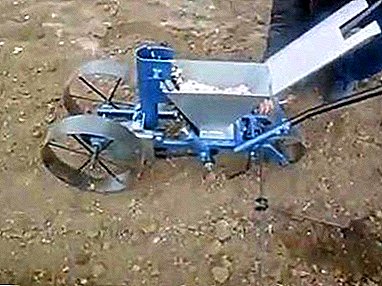 Plastic can need to drill through. The hole must be exactly in the center - this is important for the stability of the structure.
Plastic can need to drill through. The hole must be exactly in the center - this is important for the stability of the structure.- Remove the cover. On the side, make a hole in the form of a triangle (for seeds).
- Cut the lid off the tin can. It will be a valve that regulates the backfilling of seeds. The valve must be attached to the bank with a wire so that it can open and close freely.
- Cut a piece of plastic pipe and insert into the center of the can. So the bank will not shrink from tightening the bolt.
- In a piece of plastic pipe must be inserted metal tube - so the bearing will turn out. As a result, the bank should rotate - this is a sign that the design is working correctly.
- The bolt is in turn inserted into the metal pipe. It is necessary to tighten it with a nut between two washers - so the rotation will become free.
- From the side of a plastic can, a hot nail makes 2 holes. The diameter of the nail will be the same as the cloves of garlic, which will be planted.
- In the wooden handle, drill a bolt hole and fasten it to the tank (jar).
- Bend chopper and wire attached to the handle, above the tank.
On the walker with their own hands
Materials:
- channel "eight";
- wheels;
- steel sheets;
- bolts;
- nuts;
- lock nuts;
- plywood sheet;
- linseed oil;
- rubber lining;
- metal pipes;
- spikes;
- pins;
- metal hub and bearings (if you do the wheels yourself);
- chain (or belt);
- wooden boards;
- the pedals.
Inventory: welding machine.
Drawing:
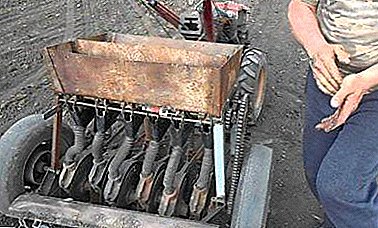 Assemble the frame. From the metal channels of the "eight" you need to weld 2 parallel spar and 3 cross member. Size is calculated in advance.
Assemble the frame. From the metal channels of the "eight" you need to weld 2 parallel spar and 3 cross member. Size is calculated in advance.- Front of the side members to weld the arch with a fork and 2 fasteners (for the lower link) on the sides.
- Fasten the support for the seed tubes on the sides of the frame.
- To strengthen the frame from the central cross member to the arch you need to weld the spikes. Strengthen the arch with two rectangular plates and steel corners (steel piece 5 mm). It should be a right triangle.
- Make a bunker. To do this, cut a sheet of plywood in accordance with the size of the frame and assemble the metal corners. The finished product is covered with linseed oil and left for a while so that it dries. It is necessary to put a rubber lining inside the bunker so as not to damage the garlic cloves or seeds.
- The hopper must be installed on the frame above. The design is fixed with four bolts with locknuts, after which a conveyor belt is installed.The conveyor can not be welded, and fasten with bolts.
- Screw the hopper firmly onto the frame (it must support a weight of up to 25 kg).
- Fix the holders of the rippers to the structure (fasten with bolts).
- Make a wheel axle. To do this, weld the pipe axle to the frame, drill holes in it for the studs holding the spikes. After complete assembly, be sure to brew pins.
- The wheels can also be assembled by yourself. To do this, put two bearings on the hub of metal and attach to the axle.
- Make a holder for rippers. Weld metal corners in the form of a square, then weld to the rod, at the ends of which steel pipes are also welded (inside them there are stands of cultivating legs).
- Weld a furrow cutter from a sheet of steel to the pipe. To control the depth of the furrow, it will be necessary to raise and lower the vas deferens.
- To drive the wheel planter connected to the wheel motoblock using a chain or belt.
- Prepare the seat and legroom. For seating, metal bars are welded to the frame on which the boards are fixed. Seat for convenience, you can beat the cloth. For legs, you need to attach to the overall design of the pedal.
Possible problems and warnings
In the manufacture of each of the drills must comply with safety. Personal protective equipment must be used: protective gloves, boots, etc.
The planter for the motoblock is difficult to assemble without welding skills. In this case, it is better to buy it in the store. The seeder for the motorblock weighs quite a lot, and during operation, the seed and the person weigh it even more heavily. Therefore, the garlic planter can tip over. To avoid this, you need to weld the counterweight. It is advisable to work together: one person will lead a walk-behind tractor, and the other will engage in planting.
- When is it best to carry out the spring sowing procedure?
- How to plant a winter variety in spring and autumn?
- What can be grown after this vegetable?
- Why do you need to observe the landing time?
- How to grow at home?
For small private farms the most suitable are self-made models.


 The owner has all the necessary materials. It is important to take a drawing in advance, according to which the planter will be created, and check whether everything is in stock. Some parts (for example, a chain) can be taken from an old bicycle, others (mounts, containers) can be taken from the garage or workshop. Of course, you can buy a couple of things, but if you separately purchase all the components, it will be easier and cheaper to buy a ready-made device.
The owner has all the necessary materials. It is important to take a drawing in advance, according to which the planter will be created, and check whether everything is in stock. Some parts (for example, a chain) can be taken from an old bicycle, others (mounts, containers) can be taken from the garage or workshop. Of course, you can buy a couple of things, but if you separately purchase all the components, it will be easier and cheaper to buy a ready-made device. Seeding type. The type of seeding does not depend on the type of garlic planter, but on the size of the bowls, the depth of planting and the number of rows. For the bulbs of garlic, planters are suitable only with small bowls, as they provide spot seeding - one bulb at a time. Large and medium bowls are suitable for teeth, in such models several teeth are planted in one place. Suitable seeding depth for seeds: 6-8 cm, and for garlic cloves: 15-20. The seeding rate depends on the rows.
Seeding type. The type of seeding does not depend on the type of garlic planter, but on the size of the bowls, the depth of planting and the number of rows. For the bulbs of garlic, planters are suitable only with small bowls, as they provide spot seeding - one bulb at a time. Large and medium bowls are suitable for teeth, in such models several teeth are planted in one place. Suitable seeding depth for seeds: 6-8 cm, and for garlic cloves: 15-20. The seeding rate depends on the rows. Manual: 1-row (10 thousand rubles).
Manual: 1-row (10 thousand rubles). Plastic can need to drill through. The hole must be exactly in the center - this is important for the stability of the structure.
Plastic can need to drill through. The hole must be exactly in the center - this is important for the stability of the structure. Assemble the frame. From the metal channels of the "eight" you need to weld 2 parallel spar and 3 cross member. Size is calculated in advance.
Assemble the frame. From the metal channels of the "eight" you need to weld 2 parallel spar and 3 cross member. Size is calculated in advance.